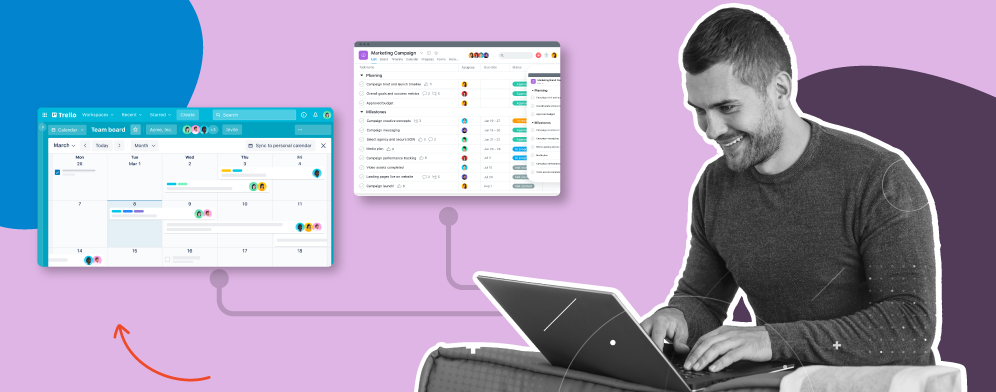1. What is Remote Project Management?
Remote project management is the process of managing a project, or several, entirely online. Every step, from initiating the project to executing and closing it, is assigned to virtual teams. Like collocated projects, remote project management consists of five steps, which are, project initiation, project planning, project execution, project monitoring, and project closure.
The remote project manager predetermines the resources, budget, and people for each phase is before kick off.
Put simply, remote project management refers to coordinating work with teammates spread across the globe. These members can be fully, partially or flexibly remote. Given that they can’t all squeeze into a conference room for updates and daily stand ups, the challenge lies in finding ways to keep the collaboration and communication as synchronous as possible.
A remote digital project manager has the added duty to report on the project’s progress to stakeholders and clients invested in the project, and these reports rely on timely and accurate feedback from the team.
1.1. What is a Remote Project?

Remote projects are time-sensitive and labor-intensive activities that teams carry out offsite. A distributed team of remote workers work on tasks that utilize their primary skills. Remote projects can have both unbilled and billable tasks. Sectors such as marketing and advertising, design, professional services, financial consulting, engineering, and ecommerce can undertake remote projects.
1.2. What is a Remote Project Team?
A remote project team refers to professionals who work on the same project but from different physical locations. For example, a project in London can have a cross functional remote team comprising members based out of the European Union, Africa or Asia.
Those companies that are 100% online default to managing projects remotely, while others have hybrid and flex teams. Hybrid teams comprises a mix of members, some of who work in-office and the others in an office-less environment. Flex arrangements mean members come in to work as well as work from anywhere for a certain number of days in the year.
2. The Difference Between Remote Project Management And Traditional Project Management Practices
Conventionally, project management success hinges on the framework and methods in play.
Depending on the business vertical and experience of the manager in question, companies adopt traditional, agile or a hybrid approach to propel the project forward, from one phase to the next.
Some of the differences between doing a project virtually and in-person include
| Traditional | Remote |
| 1. Work visibility: work stays visible because everyone is co-located, making it easy to allocate, shuffle tasks and re-assign if availability changes. | Relies on a collaborative technology stack to streamline messages, actions and assignments for everyone to view at convenience. |
| 2. Team dynamics: the team can pick up on cues from body language and sheer practice from previous size would vary based on the bodies of knowledge, experience, relevance and nature of the project, ma | Virtual 1:1s and stand ups lets team members check in on their work and that of their coworkers’. They can stay organized with automated notifications on work updates. |
| 3. Allocation estimates: cost and effort allocations are easier to estimate from experiential inputs offered by all present | Efforts are tallied against progress captured on the schedule as well as on timesheets, making it easier to re-estimate and balance workloads. |
| 4. Skills criticality: you know which skills you need, for which task and when, therefore being able to bring them in. | When a resource works remotely, you’d have to rely on digital schedules and timesheet data to determine how their skills are used and what their time is spent on. |
| 5. Constrained dependencies: you can recalculate the critical path based on interlinked dependencies, therefore knowing how much time the team is left with between the last completed milestone and the finish-line | A remote project management software helps teams login to dashboards and resolve overlapping dependencies. They can also save offline work and pick up where they last left off. |
3. Responsibilities of a Remote Project Manager

3.1. Scope Out the Project
This is the initiation step where the project’s targets, and how to reach them are chalked out. The remote project manager hashes out the project’s scope, constraints, dependencies, ,milestones and degrees of freedom with the client, stakeholder and board of investors.
3.2. Identify the Priorities
The remote project manager determines the project’s core priorities and distributes them into tasks. Breaking the project down by priorities also helps a manager to identify the type of competencies and experiential input he or she thinks the project needs. They can then request for availability statuses of those members that they will need released to the project. A standardized prioritization helps you factor in extra time to correct bugs. It also assigns people for responsibility, accountability, consulting and informing, thus preventing confusion once the project is underway.
3.3. Assemble Cross Functional Teams
This is the most crucial step after scoping out and prioritizing work. A distributed team gives you the added advantage of tapping into a diverse talent base without incurring fixed costs to maintain an office space. A few tips that help remote project managers assemble a high-performing remote project team are:
3.3.1. Evaluate the Skills Matrix
Get a thorough idea of the skills you’ll need and match them to the ones in the employee database. Look into historic records for those people with experience working on similar projects and check their available work hours by percentage (100%, 50%, 20% etc). This helps you ensure you’re not overbooking them.
3.3.2. Be Emphatic About Remote Team Communication
Trust is at the center of all activity and it can be facilitated only if a project manager and his team keep the communication going at both ends. Make yourself available to your team to answer concerns, suggest resolution measures and build the rapport as you go along. The more intentional you are about being approachable, the more comfortable teams are about coming forward with feedback and output.
3.3.3. Enable Self-Sufficiency
It is impractical for a remote project manager to handhold individual members. Therefore, master delegation through process steps. It helps you understand when to step in and step back.
3.3.4 Invite Team Members to Submit Ideas
In continuation to point 2, always demonstrate your willingness to hear out ideas. The fresh perspective can unstick a bottleneck and help you and the other teammates see things differently.
3.3.5. Leverage the Right Tools
Ensure there’s an agreement to the number and type of tools you’ll expect the team to use. Filter usage by purpose, such as Standuply for virtual standups and project assistance. Everyone getting onto the same tool brings about consistency in information sharing and knowledge contribution. It also speeds up work and prevents anyone from having to frantically comb through several different platforms to retrieve missing pieces of information.
3.4. Roadmap Project Delivery
A project roadmap is where you map the project journey for the virtual team. Everyone relevant has to be in attendance when you go over the goals, output, work breakdown and expectations. This is the phase that answers questions, and enables teams to get a clear picture of the dependencies in play, their role and extent of involvement. The project roadmap should communicate to teams what the client expects, and how it aligns with what they as the driving force are doing.
3.5. Assign Tasks to Remote Members
The project manager in charge of managing projects remotely should be able to identify those tasks and skills that go together and assign them appropriately. The individual start and finish times for each task should be clearly conveyed so that it does not adversely impact other tasks in the chain of events.
3.6. Streamline Workflows
A remote project manager benefits from using a centralized project management tool to unify workflows. They can view progress, and subscribe for alerts to threads that members mention them in. Being able to track progress on workflows lets project managers see where the struggle lies, and makes the process of managing the project more transparent and seamless.
3.7. Match Outcomes to Desired Deliverables
A critical responsibility for remote project managers is to ensure that deliverables at the end of each iteration matches expectations before getting to the end. This requires the manager to habitually check in on inflight iterations and update to the client regarding the progress and estimated time to indicate if the work will be ahead, on-schedule or delayed.
3.8. Conduct Project Reviews
Retrospective meetings are facilitated by a project manager to get the teams together to celebrate wins, acknowledge efforts and provide them with feedback. These reviews help teams also record their on-project experience into a lessons learned document for future remote teams to look at for answers.
4. Benefits of Managing a Project Remotely
4.1. Cost-Effectiveness
Remote projects not only save employees transportation costs but also enable offices to cut back on renting, maintenance expenses and energy consumption. It's also better for a greener planet, given that there will be fewer commuters on the road traveling solo or by carpooling! Remote hiring to fill in for project requirements can expose your organization to a diverse talent pool without having to sponsor or negotiate relocation assistance.
One-off project requirements can be freelanced instead of assigning them to full-time remote staff. The only thing you’ll need to pay attention to is making independent contractors feel included and aware of your expectations, and how your business works.
4.2. Increased Productivity
A Hubstaff report reveals that 65% of remote workers are more productive, and 86% of these employees rate their productivity from ‘good’ to ’excellent’. One of the reasons attributed to this is that employees are less likely to fall ill and be absent when working from home. The consistency in attendance also ensures that they do not miss any relevant work-related update and can pick up from where they left off.
While communication does matter, in-office interactions do run the risk of distracting workers from what they’re doing. Remotely, however, employees can inform others of when they’re going to be busy to ensure they are not disturbed when they have their head down in work.
And I haven’t gotten to the best part yet. Now that you don’t have anywhere else to go, you won’t misplace or forget hard copies of important files and notes that you’ll be referring to in discussions, meaning that any project-related meeting can start and end on time!
4.3. Increased Utilization of Project Management Tools
With everyone digitally available, you get more use out of an online project management system to record tasks, manage progress, and communicate actions and decisions to each other. As you master the basics of the tool, you’ll know what features to use and will not need to be trained to use a new product. The onboarding is comparatively easier, and saves hours with the familiarity of how the tool works.
4.4. Lowered Stress Levels
Remote project management gives you the flexibility to manage how much you can get done in the time given. With practice, you’ll be able to manage your time better, lowering the stress associated with getting things up and running on time. You are also able to be around for your family and friends and have a life outside of work to socialize and recharge.
5. Challenges of Remote Project Management
The benefits of remote work are great, but remote project management is not challenge-free.
Some challenges include:
5.1. Team Coordination and Synchrony
You have to coordinate work which is compounded when teams are spread across the world. The trust factor has to be high to get the team to move forward as a single unit.
5.2. Inconsistencies in What Gets Communicated
Inconsistent communication results in partial or delayed updates. Some members are more proactive than the others in updating you. This makes it difficult to gauge if everybody is putting in the required efforts, or are slowing their team down. Besides keeping goals visible and clarifying expectations, remote project managers have to be more deliberate about the purpose of communication, the medium through which updates are sent through and uniformity. In meeting, virtual managers have to observe participation and ensure that they are noticing and crediting contributions from all.
5.3. Lack of Unified KPIS
You have to consciously knit the team together to cultivate the ideal group dynamic. Only then can everyone justify where and what their time went into. The saying, ‘you cannot measure what you do not track’ holds true for remote projects. Even with the team keeping you abreast of what’s happening, without a mechanism to identify and institute the right metrics to compare against your project’s Key Performance Indicators (KPIs), there is no point in insisting on team accountability. You’ll be further away from knowing if the milestones reached are in line with expectations.
5.4. Unresolved Workplace Conflict
Another less mentioned, yet significant challenge associated with remote project management is attempting to remain impartial when there’s a workplace conflict. Disagreeing parties can halt progress to the point that they may even leave the team hanging due to the inability to reach an understanding.
6. How Do You Manage Projects Remotely?
6.1. Be Consistent and Deliberate in Your Communication
It's important to communicate before, during and after a project. The feedback you get at the start will change as the project progresses, which is a more accurate representation of what’s going on in your staff’s mind. For instance, preempting a challenge early-on can change your worker’s opinion of why it was difficult, and enable them to recognize the factors and bear it in mind for next time.
6.2. Limit Meetings to Relevance
Have meetings, but keep them relevant and get straight to the point. Try to recreate the sense of being in an actual office by encouraging audio-enabled video calls. It lets people remain mindful of their conduct and be more attentive to what everyone is saying. The exception to this is if anyone’s experiencing connectivity issues and is having to frequently weave in and out of the meeting. In such cases, take the conversation offline.
Always remember to summarize the minutes of the meeting into an email or document template for people to revisit. Have meetings with your client as well and keep remote teams informed of developments so that they can gear up for any changes requested. Meetings create virtual touchpoints and make you reachable to both clients and remote teams. This eliminates the frustration of not knowing what’s happening.
6.3. Encourage Specificity
Remote project management should not have the room for vague questions for people to make sweeping assumptions. Get teams to go into the specifics and make the time to hear them out so that you get the complete picture. It will help you guide them better and give well-rounded feedback and suggestions that they can act on.
6.4. Involve Everyone in the Kickoff
Always get the project off the ground with the involvement and inclusion of your remote team. It helps them see how the project started, where they come in and who all they’ll be working with. It also prevents unilateral decisions and gives the team more autonomy over completing the tasks. The The project kickoff keeps everybody on the same page from the outset. You can share the draft schedule with both the client and team and answer questions regarding key dates, conveyance of updates and how internal communication will be handled across the distributed workforce.
6.5. Document Everything
Always compile the project charter, notes, work statements, processes and frameworks. Insist on your team members doing so in order for there to be a sufficient repository to look at once the project commences. This knowledge base can be updated as and when new information comes in, ensuring that members know where to go for the answers. The more comprehensive, the better.
7. Project Management Tools for Remote Managers

Remote managers will need tools to record decisions, facilitate conversations and collaboration, enter and manage tasks. A few such project management tools include
7.1. Monday.com
Monday.com is a project management tool that connects and engages the remote network. It was founded in 2012 and is best known for aligning remote teams through business hours. Monday.com has an extensive library of template designs with drag-and-drop blocks to customize your very own template.
7.2. ClickUp
ClickUp is a work management and project planning tool that comprises goal tracking,time tracking,screenshot and recording options. ClickUp was founded in 2017 and lets remote teams make use of extensive documents and wikis to stay on top of their work.
7.3. Smartsheet
Smartsheet is a great project management tool for sales teams. Launched in 2006, Smartsheet is packed with template libraries, pre-filled sheets, reports, and dashboards that are customizable to the user’s needs. The Smartsheet platform comes with Gantt timelines, cost estimation and team collaboration
7.4. Hive
Hive is a powerful project management tool platform that is multi-provisioned. From Kanban boards to Gantt, Hive lets remote teams use a facility that they are truly comfortable with. Hive’s first prototype came out in 2015, and then acquired over 2000 enterprise teams a year later. Rich features include time tracking to track how much time teams are spending on projects, bulk-repeat tasks with action templates and flexible project charting.
7.5. Teamwork
Teamwork is a project management software with time tracking, team collaboration and a template library. Founded in 2007, this tool enables you to stay deadline-driven, manage priorities, track progress and hit goals. It also has a resource management component to smooth out workloads so that people aren’t over or under booked onto projects.
8. Can a Project Manager Work Remotely?
The short answer is yes.
The long answer? A project manager can work remotely provided he or she, and the team they’re leading are upfront and honest with each other. It's about cultivating a work environment that enables people to bring their best to the table. Given that a project depends on the right skills meshing, making the time and effort to recognize contributions helps the team to learn, and grow.
You’ll need to accept the fact that you’ll be communicating more in order to make sure everybody stays in their lane. You’ll also have to plan your schedule to accommodate looking into requests and work statuses coming in from different employees. This will mean upping your own time management and organizational skills in order to set the right example for the team you are leading.
9. FAQs
9.1. How to do project management remotely?
Implement robust communication tools, set clear goals and deadlines, utilize project management software, conduct regular check-ins, and establish transparent workflows to effectively coordinate and manage remote teams.
9.2. What is the role of remote teams in project management?
Remote teams play a pivotal role in project management by contributing diverse skill sets, fostering innovation, maintaining flexibility, and leveraging technology to collaborate efficiently towards achieving project goals regardless of geographical barriers.
 Interested in Virtual Team Building Events?
Interested in Virtual Team Building Events?





















